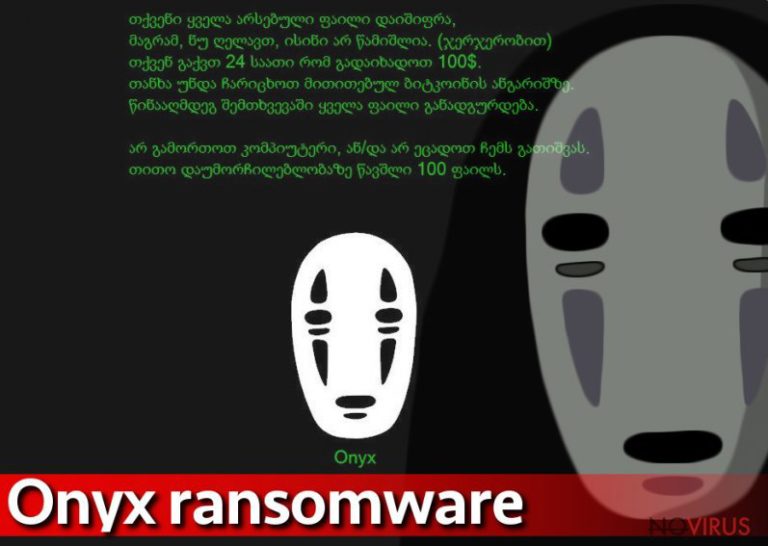Uninstall Onyx virus (Virus Removal Tutorial)
Onyx virus Removal Guide
Description of Onyx ransomware virus
Onyx ransomware attacks computer users from Georgia
Onyx ransomware virus is one of the latest cyber threats which targets a considerably small group of computer users. The creators of the ransomware are not so ambitious and only targets people living in Georgia. Therefore, if you live in this country, you should take some precautions in order to avoid this file-encrypting virus: install a strong antivirus program, get used to double check the information before opening email attachments, do not browse on high-risk websites and do not install questionable software or their updates from suspicious domains. Besides, you should make backup copies of all your important files. One Onyx virus gets inside the computer it corrupts all your personal data. The possibility that some of your documents, pictures or audio collection will survive the attack is little. Malware acts silently and only when it finishes file encryption process, it informs victim what have happened by changing affected computer’s background picture and leaving a ransom note. If you are one of the unlucky ones who have encountered this ransomware, you should not let cyber criminals blackmail you. Hackers ask to pay the ransom for a possibility to decrypt locked files, but instead of reaching for your credit card, remove Onyx from the computer. The virus is capable of installing additional malware that makes your computer’s state even more vulnerable. Therefore, scan your PC with FortectIntego or other reputable malware removal program and start virus elimination process.
The ransom note delivered by Onyx ransomware is written in Georgian. Some ransomware viruses offer to read messages in other languages as well, so it seems the authors of this ransomware are not willing to spread broader and target their homeland only. However, hackers might have failed a little or Onyx is their first attempt to create a ransomware. They haven’t provided a necessary Bitcoin wallet address, so it’s impossible to pay the ransom even if you consider doing it. On the one hand, it’s impossible to decrypt files locked by the ransomware; on the other – you saved 100 US dollars that cyber criminals asked you to pay. What should you do now? Initiate Onyx removal.

Transmission methods
Onyx virus might enter your computer using different methods and techniques. It might infiltrate the system as a Trojan horse or use exploit kits. Moreover, users might let it inside when they open infected email attachment, click on malware-laden advertisements, install or update fake software. Nowadays, the most popular way to spread ransomware is malvertising. Cyber criminals launch numerous spam email campaigns and trick users into opening an infected attachment. The malicious file might look like innocent Word or PDF file, but once users open it, malware sneaks in and starts unstoppable data encryption process. Therefore, if you want to avoid Onyx ransomware and other malware, you should always double check information about the sender before opening any email attachment sent by the unknown sender. Besides, you should avoid visiting suspicious and high-risk websites or click on strange ads. Bear in mind that malware-laden ads usually offer download software, update programs or warn about detected computer errors. Never click on them!
Best way to eliminate Onyx ransomware virus
Onyx malware belongs to one of the most dangerous types of cyber threats. Therefore, forget an idea to remove ransomware manually. It’s a complicated and difficult computer infection that is not easily removable. Only experienced IT specialists can eliminate virus bare hands. However, you don’t need to bring your computer to any IT specialist and ask for help with Onyx removal. You can get rid of the virus at home, using professional malware removal tools. We recommend installing FortectIntego, SpyHunter 5Combo Cleaner or Malwarebytes. If you want, you can use another strong antivirus program, but don’t forget to update it first. Besides, the virus can block access to the program. If it happens, follow the instructions how to remove Onyx under these conditions below.
Getting rid of Onyx virus. Follow these steps
In-depth guide for the Onyx elimination
Important! →
The elimination guide can appear too difficult if you are not tech-savvy. It requires some knowledge of computer processes since it includes system changes that need to be performed correctly. You need to take steps carefully and follow the guide avoiding any issues created due to improper setting changes. Automatic methods might suit you better if you find the guide too difficult.
Step 1. Launch Safe Mode with Networking
Safe Mode environment offers better results of manual virus removal
Windows 7 / Vista / XP
- Go to Start.
- Choose Shutdown, then Restart, and OK.
- When your computer boots, start pressing the F8 button (if that does not work, try F2, F12, Del, etc. – it all depends on your motherboard model) a few times until you see the Advanced Boot Options window.
- Select Safe Mode with Networking from the list.

Windows 10 / Windows 8
- Right-click the Start button and choose Settings.

- Scroll down to find Update & Security.

- On the left, pick Recovery.
- Scroll to find Advanced Startup section.
- Click Restart now.

- Choose Troubleshoot.

- Go to Advanced options.

- Select Startup Settings.

- Press Restart.

- Choose 5) Enable Safe Mode with Networking.
Step 2. End questionable processes
You can rely on Windows Task Manager that finds all the random processes in the background. When the intruder is triggering any processes, you can shut them down:
- Press Ctrl + Shift + Esc keys to open Windows Task Manager.
- Click on More details.

- Scroll down to Background processes.
- Look for anything suspicious.
- Right-click and select Open file location.

- Go back to the Process tab, right-click and pick End Task.
- Delete the contents of the malicious folder.
Step 3. Check the program in Startup
- Press Ctrl + Shift + Esc on your keyboard again.
- Go to the Startup tab.
- Right-click on the suspicious app and pick Disable.

Step 4. Find and eliminate virus files
Data related to the infection can be hidden in various places. Follow the steps and you can find them:
- Type in Disk Cleanup in Windows search and press Enter.

- Select the drive (C: is your main drive by default and is likely to be the one that has malicious files in) you want to clean.
- Scroll through the Files to delete and select the following:
Temporary Internet Files
Downloads
Recycle Bin
Temporary files - Pick Clean up system files.

- You can also look for other malicious files hidden in the following folders (type these entries in Windows Search and press Enter):
%AppData%
%LocalAppData%
%ProgramData%
%WinDir%
After you are finished, reboot the PC in normal mode.
Eliminate Onyx using System Restore
-
Step 1: Restart your computer in Safe Mode with Command Prompt
Windows 7 / Vista / XP- Go to Start → Shutdown → Restart → OK.
- As soon as your computer starts, start pressing F8 key repeatedly before the Windows logo shows up.
-
Choose Command Prompt from the list

Windows 10 / Windows 8- Click on the Power button at the Windows login screen, and then press and hold Shift key on your keyboard. Then click Restart.
- Then select Troubleshoot → Advanced options → Startup Settings and click Restart.
-
Once your computer starts, select Enable Safe Mode with Command Prompt from the list of options in Startup Settings.

-
Step 2: Perform a system restore to recover files and settings
-
When the Command Prompt window appears, type in cd restore and press Enter.

-
Then type rstrui.exe and hit Enter..

-
In a new window that shows up, click the Next button and choose a restore point that was created before the infiltration of Onyx and then click on the Next button again.


-
To start system restore, click Yes.

-
When the Command Prompt window appears, type in cd restore and press Enter.
Bonus: Restore your files
Using the tutorial provided above you should be able to eliminate Onyx from the infected device. novirus.uk team has also prepared an in-depth data recovery guide which you will also find above.There’s no Onyx decryption tools available at the moment. At the moment you can recover lost files from backups or use alternative method presented below. We cannot assure that this method will decrypt all files, but you can still give it a try.
There are a couple of methods you can apply to recover data encrypted by Onyx:
Data Recovery Pro
This tool was created for locating and restoring corrupted files after system wreckage; however, it might be helpful in restoring files encrypted by Onyx ransomware.
- Download Data Recovery Pro;
- Install Data Recovery on your computer following the steps indicated in the software’s Setup;
- Run the program to scan your device for the data encrypted by Onyx ransomware;
- Recover the data.
It is strongly recommended to take precautions and secure your computer from malware attacks. To protect your PC from Onyx and other dangerous viruses, you should install and keep a powerful malware removal tool, for instance, FortectIntego, SpyHunter 5Combo Cleaner or Malwarebytes.
How to prevent from getting ransomware
Securely connect to your website wherever you are
Sometimes you may need to log in to a content management system or server more often, especially if you are actively working on a blog, website, or different project that needs constant maintenance or that requires frequent content updates or other changes. Avoiding this problem can be easy if you choose a dedicated/fixed IP address. It's a static IP address that only belongs to a specific device and does not change when you are in different locations.
VPN service providers such as Private Internet Access can help you with these settings. This tool can help you control your online reputation and successfully manage your projects wherever you are. It is important to prevent different IP addresses from connecting to your website. With a dedicated/fixed IP address, VPN service, and secure access to a content management system, your project will remain secure.
Reduce the threat of viruses by backing up your data
Due to their own careless behavior, computer users can suffer various losses caused by cyber infections. Viruses can affect the functionality of the software or directly corrupt data on your system by encrypting it. These problems can disrupt the system and cause you to lose personal data permanently. There is no such threat if you have the latest backups, as you can easily recover lost data and get back to work.
It is recommended to update the backups in parallel each time the system is modified. This way, you will be able to access the latest saved data after an unexpected virus attack or system failure. By having the latest copies of important documents and projects, you will avoid serious inconveniences. File backups are especially useful if malware attacks your system unexpectedly. We recommend using the Data Recovery Pro program to restore the system.







